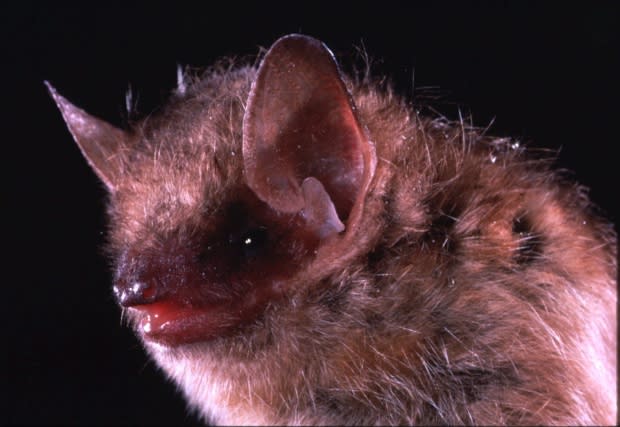What you need to know about rabies in Canada
Public health officials and scientists stress that rabies rarely infects humans in Canada, but the death of a man in British Columbia who came into contact with a bat is a reminder to take precautions with wildlife.
B.C.'s provincial health officer, Dr. Bonnie Henry, said Tuesday that the 21-year-old man was exposed during the day outdoors when a bat essentially ran into his hand. The man was exposed in mid-May on Vancouver Island.
Six weeks later, he began showing symptoms. He died in Vancouver on Saturday.
Rabies is transmitted through the bite or scratch of an infected animal. It is usually passed from animal to animal and rarely affects humans.
Since reporting began in 1924, the federal government reports a total of 25 people in six provinces have died of rabies in Canada. There have been three human deaths from exposure to rabid bats in this country since 2000.
"This is an extremely rare event," said Paul Faure, who studies bat echolocation and hearing at McMaster University's psychology department in Hamilton, Ont.
Other mammals known to transmit the disease in Canada include raccoons, foxes and skunks. The rabies virus typically lives in these wild animals and act as a reservoir for the disease, the Canadian Food Inspection Inspection said in an email.
Health officials say the best way to avoid rabies is to stay away from wildlife.
Identifying human cases
People are encouraged to go to a doctor or medical officer of health if they've been bitten to start treatment, but there is no need to panic because death isn't imminent, Faure said.
People who've been exposed in remote locations have received treatment and recovered. Post-exposure treatment is a shot containing antibodies to destroy the virus at the wound site and four shots of rabies vaccine.
Contact can include a bite, scratch or brushing against an animal, Faure said. Just as people often don't notice a small sliver; it is also possible not to realize you've been exposed to a bat, which can sometimes be hidden.
Handling a bat likely warrants seeking medical attention to be assessed.
In the B.C. death, Henry said the man's symptoms progressed quickly.
Animal behaviour
When an animal is infected with rabies and develops signs, its behaviour changes. Symptoms can include walking abnormally, difficulty swallowing, drooling or foaming at the mouth.
And as in the B.C. case, a bat that is normally active at night could venture out in the day when rabid.
The signs and behaviours can vary and be confused with other diseases, according to the federal government.
Faure said that in Canada, healthy bats in the wild aren't randomly sampled to test for rabies. The bats that are tested at provincial labs are those sent in after suspicious interactions or that seem sick.
There are no reliable tests to detect rabies in people or animals before signs and symptoms occur.

Animals need to be killed to test for rabies.
Some animals that people may think spread rabies – like opossums and squirrels – rarely do.
What to do if you think you've been exposed
People who've been bitten, scratched or licked by an animal you think has rabies should go to the hospital right away.
To reduce the risk of developing rabies, public health officials advise:
Remove any clothing contaminated with an infected animals saliva, brain and nervous system tissue or fluids.
Thoroughly clean the wound.
Do not cover the wound.
If for instance a bat is flying in your home while someone is asleep, the sleeping individual is also encouraged to seek medical attention.
How rabies transmits
Henry said rabies virus is transmitted through direct contact (such as through broken skin or mucous membranes in the eyes, nose or mouth).
People usually get rabies from the bite of a rabid animal.
"It is also possible, but rare, for people to get rabies from non-bite exposures, which can include scratches, abrasions, or open wounds that are exposed to saliva or other potentially infectious material from a rabid animal," according to the U.S. Centers for Disease Control and Prevention's website.
Even rarer modes of transmission include inhaling aerosolized rabies virus when working with it in a laboratory and from corneal or solid organ transplants.
Laboratory workers who handle the rabies virus, veterinarians, animal control workers, and hunters and trappers in areas with confirmed rabies are among those offered rabies immunization before exposure.
How exposures are treated
Health-care providers will determine if you need preventive treatment depending on factors such as the animal involved, type of exposure and whether rabies circulates where you are.
Henry said rabies has an incubation period from when someone is exposed to the virus to when an infection and symptoms start.
"That is one of the tricky things about this disease because people may not associate the early symptoms with the exposure that they might have had months and weeks ago."
There is a rabies vaccine to prevent infection and injections of immunoglobulins (antibodies) to help your immune system to fight the virus. This is called postexposure prophylaxis (PEP).
Rabies is fully preventable with PEP, the CDC said last month.
Current vaccines are relatively painless and are given in your arm like a flu shot. Rabies vaccines are not given in the stomach, the CDC said.
There's no specific treatment for rabies once symptoms appear. Once symptoms are present, death usually occurs within seven to 14 days.
Usually, Henry said, early symptoms are pain and tingling around where the contact was made, which spreads through the nerves and can cause weakness and symptoms such as fever and headache.
Dogs
Dogs are carriers of rabies in some countries, but vaccination programs have eliminated the pets as a reservoir in Canada.
To keep it that way, dogs imported into the country need to have their documents inspected by the Canadian Border Services Agency to ensure rabies vaccination is up to date.


